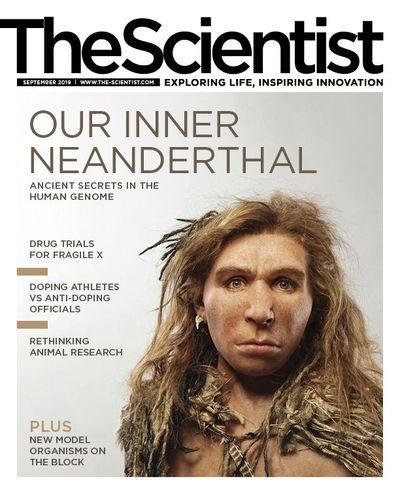Login
SubscribeFeatures

The Race to Nab Cheating Athletes
Anna Azvolinsky | Sep 1, 2019 | 10+ min read
Anti-doping organizations are constantly developing new tests to catch athletes trying to boost their performance in increasingly sophisticated ways.

Neanderthal DNA in Modern Human Genomes Is Not Silent
Jef Akst | Sep 1, 2019 | 10+ min read
From skin color to immunity, human biology is linked to our archaic ancestry.

Recent Trials for Fragile X Syndrome Offer Hope
Randi Hagerman | Sep 1, 2019 | 10+ min read
Despite a solid understanding of the biological basis of fragile X syndrome, researchers have struggled to develop effective treatments.
Contributors
Contributors
Contributors
Meet some of the people featured in the September 2019 issue of The Scientist.
Editorial
Does Our DNA Make Us All Unique or All the Same?
Does Our DNA Make Us All Unique or All the Same?
A better understanding of the genetic diversity among humans could motivate an appreciation of both our similarities and our differences.
Speaking of Science
Ten Minute Sabbatical
Ten Minute Sabbatical
Take a break from the bench to puzzle and peruse.
Notebook
How Evolution Made the Highveld Mole Rat Impervious to Ant Stings
How Evolution Made the Highveld Mole Rat Impervious to Ant Stings
Researchers identify changes to a pain receptor and to an ion channel that appear to enable the rodents to colonize otherwise inhospitable burrows.
Exploding Stars Probably Didn’t Spur Hominins to Walk Upright
Exploding Stars Probably Didn’t Spur Hominins to Walk Upright
The astronomical idea doesn’t align well with the fossil record, anthropologists argue, but the origins of bipedalism are still difficult to determine.
Saving the Hellbender, a Giant Salamander Under Threat
Saving the Hellbender, a Giant Salamander Under Threat
Populations of the two-foot-long amphibians are declining across North America. Scientists are struggling to find out why, before it’s too late.
Genes that Are Harmless on Their Own Cause Disease When Combined
Genes that Are Harmless on Their Own Cause Disease When Combined
A case study of a family demonstrates that different genetic mutations from the two parents cause severe heart disease symptoms in the children.
Critic at Large
Opinion: Greater Diversity Is Needed in Human Genomic Data
Opinion: Greater Diversity Is Needed in Human Genomic Data
Researchers must ensure that the inequality seen in most of today’s genomic studies and databases is corrected.
Modus Operandi
Light-Activated Nanodevices Control Cells
Light-Activated Nanodevices Control Cells
DNA-coated gold nanorods enable cells to be activated by light without genetic manipulation.
The Literature
A Synthetic Ion Channel Makes Plants Grow Faster
A Synthetic Ion Channel Makes Plants Grow Faster
Arabidopsis with guard cells modified by a light-activated potassium ion channel can open and close stomata more quickly, conserving water.
The Biology of Suicidal Thoughts in PTSD Patients
The Biology of Suicidal Thoughts in PTSD Patients
Researchers link levels of a receptor in the brain to suicidal ideation in people with post-traumatic stress disorder.
Researchers Discover New Family of Viruses
Researchers Discover New Family of Viruses
The redondoviruses, named for their circular DNA, inhabit the human respiratory tract and may be linked to disease.
Profile
Defining Rare Disorders: A Profile of Judith Hall
Defining Rare Disorders: A Profile of Judith Hall
By bringing genetics into clinical medicine, the University of British Columbia medical geneticist helped to identify the gene mutations responsible for many rare diseases.
Scientist to Watch
Cigall Kadoch Unravels Chromatin’s Role in Cancer
Cigall Kadoch Unravels Chromatin’s Role in Cancer
The Dana-Farber Cancer Institute researcher is developing cancer therapeutics based on how the physical structure of DNA contributes to the disease.
Lab Tools
Genetics Models Move Beyond Drosophila and the Humble Lab Mouse
Genetics Models Move Beyond Drosophila and the Humble Lab Mouse
Organisms with unusual genomes are helping scientists investigate gene regulation, evolution, and development.
Careers
Fixing the Flaws in Animal Research
Fixing the Flaws in Animal Research
Many preclinical studies carried out in vivo are poorly designed and generate irreproducible data, but efforts to address the problem are on the rise.
Reading Frames
Can Genetics Explain Human Behavior?
Can Genetics Explain Human Behavior?
The author of a new book about emerging concepts in human genetics considers the question.
Foundations
Modern Synthesis, 1937
Modern Synthesis, 1937
Theodosius Dobzhansky’s work in population genetics influenced how genetics and natural selection were combined in evolutionary biology.
Infographics
Infographic: How to Catch Cheating Athletes
Infographic: How to Catch Cheating Athletes
Anti-doping agencies are tracking levels of various molecules in athletes’ blood and urine over time to increase their ability to detect drug misuse.
Infographic: History of Ancient Hominin Interbreeding
Infographic: History of Ancient Hominin Interbreeding
See when and where our ancestors may have interbred with Neanderthals and Denisovans.
Infographic: The Genetics of Fragile X Syndrome
Infographic: The Genetics of Fragile X Syndrome
Variation in the number of CGG repeats in the FMR1 gene at the bottom of the X chromosome can lead to increased levels of mRNA or decreased levels of protein—both conditions that cause disease.
Infographic: Optogenetics Without Genetic Engineering
Infographic: Optogenetics Without Genetic Engineering
DNA-loaded nanoparticles that respond to infrared light provide an alternative way to control cell behavior.
Infographic: Open and shut
Infographic: Open and shut
Researchers devise a way to make plants’ stomata open and close more quickly.























